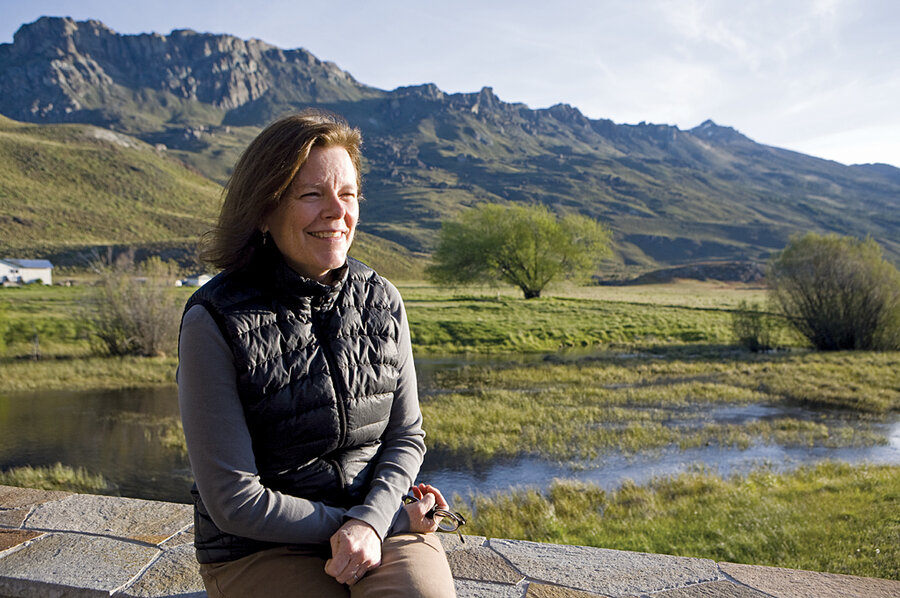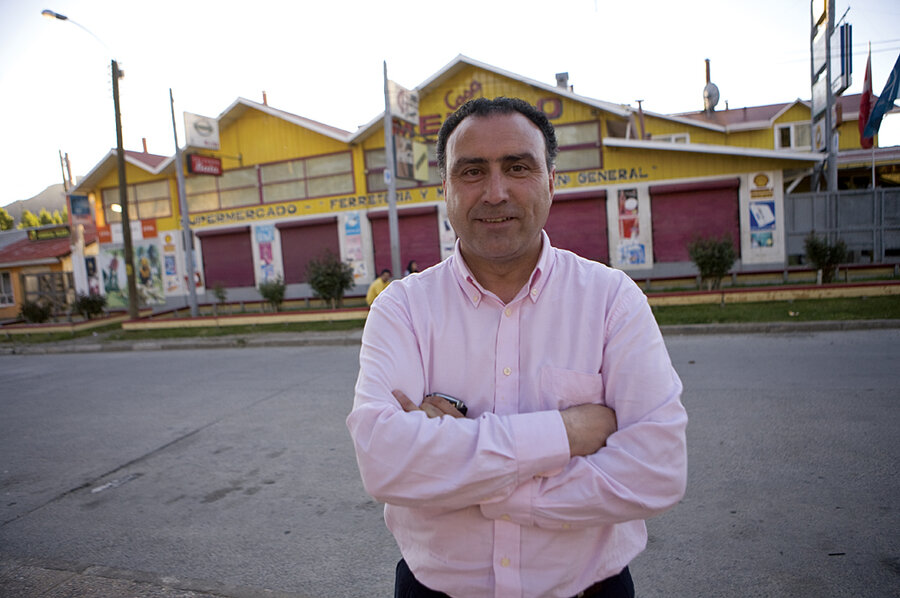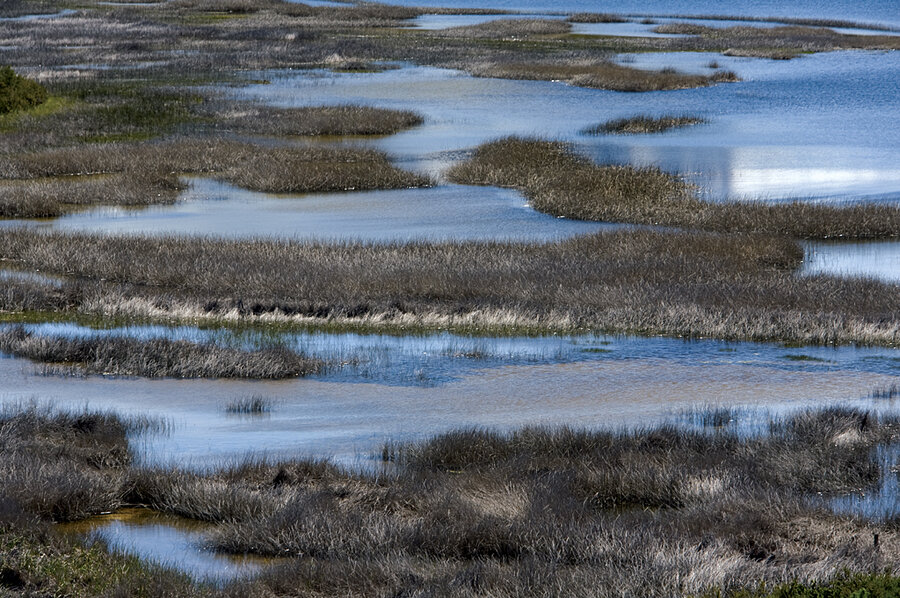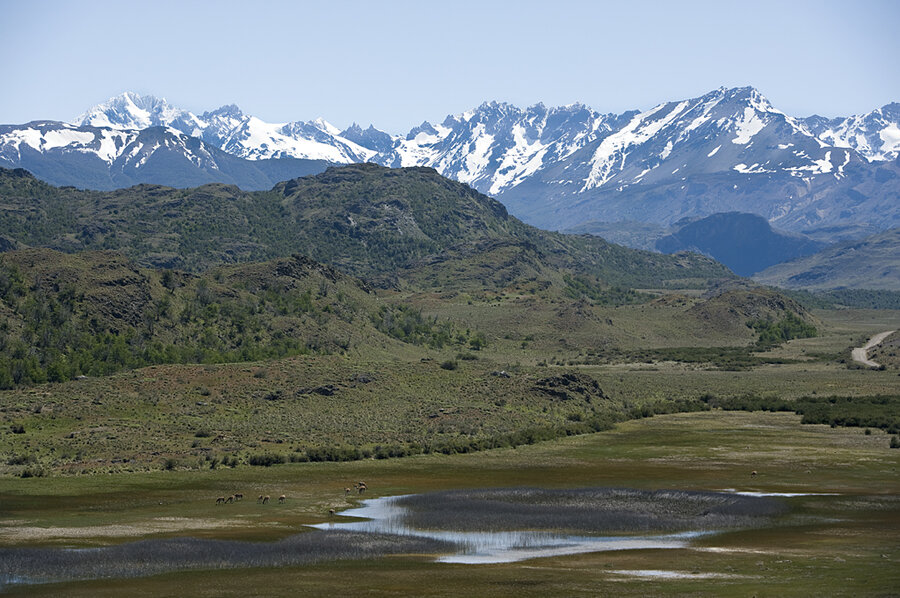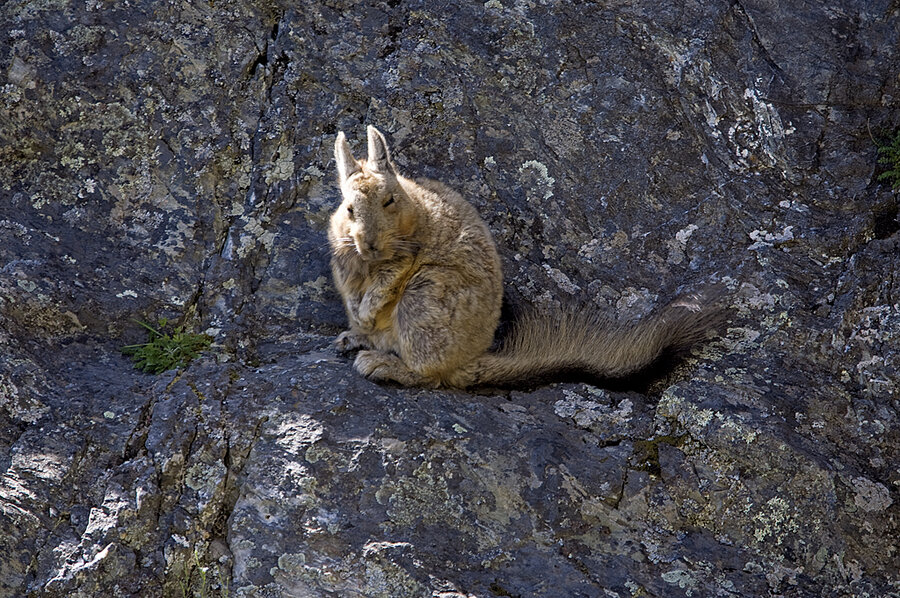Eco-philanthropists to the rescue of wildlife?
Loading...
| Estancia Valle Chacbuco, Chile
While everyone else is sitting down to dig into a roast-chicken dinner, hostess Kristine McDivitt Tompkins is padding around her lodge barefoot, binoculars in hand, charting the movement of a duck on the pond outside.
When she finally tears herself away from the picture window – which frames the rolling hills of her $10 million, 173,000-acre Patagonian spread – to sup with her guests, it's with a bird book open next to her plate so she can annotate the guests' sightings. And no one dares a lengthy deliberation on politics or the personal; Ms. Tompkins steers all conversation straight to her obsession: wildlife.
"I have always had a real affinity for the nonhuman world," explains the former CEO of the outdoor clothing company Patagonia. Her extraordinary wealth has allowed her – and her husband, Doug Tompkins, also a former outdoor clothing magnate who founded The North Face – to bankroll that simple sentiment into a complex crusade to save vast tracts of South American wilderness.
This power couple leads a movement of like-minded monied conservationists – eco-barons who, instead of waiting for the world to grow an environmental consciousness, are purchasing land with their own money and protecting it themselves. This band of former executives and entrepreneurs generally donates tracts as new national parks or preserves.
The Tompkinses have purchased 2 million acres in Argentina and Chile and already created two national parks. Their latest project here, on the rolling, dry steppe that was once one of the Chile's largest sheep ranches, is named, for now, the Future Patagonia National Park.
Called everything from spies to Zionists set on creating a Jewish state in Chile (neither of them is Jewish), the Tompkinses have not always been well received.
For example, one vast parcel they purchased – a swath running from the Argentine border in the Andes to the Pacific, known as Pumalin Park – literally cut the narrow nation in two, arousing nationalist sentiments against them. They've been derided as a part of a "green" chic trend, where the nouveaux riches are no longer buying the landscapes of the great painters but the landscapes themselves.
"Many people would love to see Doug leave Chile and never come back," concedes Ms. Tompkins. But that has zero impact on the couple's single-minded and – in their minds – desperate drive to help save the planet.
"I do not want to live in a world where there are no orangutans, or Magellanic woodpeckers," she says. "You have to conserve large tracts of land to preserve biodiversity."
Certainly most environmentalists could never dream of the resources the former retail clothing giants wield. But they are not lone wolves; they head a pack of ecophilanthropists who are taking conservation upon themselves.
Largely American, and often entrepreneurs from Wall Street or the West Coast, they have recast the mold of the philanthropists of the 20th century who helped assemble the jewels in the crown of the US National Park Service.
Among others, for example, there is Roxanne Quimby, the former owner of Burt's Bees products who has been buying up land in Maine's Great North Woods to create a national park. And Gordon Moore, the founder of Intel, who has poured in millions to save the Amazon. Heiress Katharine Ordway has given more than $64 million to create preserves including the 8,100-acre Konza Prairie Research Natural Area in Kansas. And real estate investor M.C. Davis sealed off 48,000 acres in the Florida Panhandle.
"There is a resurgence of park-related philanthropy," says Tom Butler, a friend of the Tompkinses who wrote the 2008 book "Wildlands Philanthropy: The Great American Tradition." "There is this new category of highly entrepreneurial conservation philanthropist."
But this is not just the hobby of the rich.
The movement aimed at conserving land has mushroomed among ordinary Joes with the growth of organizations such as the Land Trust Alliance (LTA), in which landowners can donate easements to permanently limit uses of land. The US-based group says the number of land trusts has grown to 1,667 in the United States, a 32 percent increase over five years.
Their motivations might be as simple as not wanting to see the woods they used to play in turn into yet another housing development. "People are realizing if they do not do something now, all of their favorite places will be gone," says Rob Aldrich, director of information services at the LTA.
As Mr. Butler puts it, to participate "you do not have to be a Rockefeller or DuPont." Or, he could have added, a Tompkins.
The Tompkinses, avid skiers and hikers, fell in love with Patagonia, taking camping trips each April – in the Austral autumn – throughout its nooks and corners, until finally settling there. Today Ms. Tompkins cannot put into words what draws her here, but both left corporate America and put their efforts full-time into conservation.
Mr. Tompkins, in 1990, founded the Foundation for Deep Ecology, which espouses the holistic philosophy that humans are part of nature as a whole, and that nature is not to be used solely for human purposes. To carry out their South American work, he created the Conservation Land Trust, and she created Conservacion Patagonica.
Their newest national park project sits beneath the snowcapped Andes where guanacos (Andean llamas) graze the steppe near the Argentine border, a seven-hour drive from the closest airport down the dirt road called the Austral Highway. This tract, where the Tompkinses have a home, used to be one of the biggest sheep ranches in the country, with hundreds of miles of fencing that the national park staff and a rotating group of volunteers are now removing. The land was overgrazed; now, with all the animals sold off except those for employee consumption, vast fields of grass thrive.
Former ranchers have been retrained as park rangers. They once hunted pumas to protect their sheep; now they track them with satellite collars to ensure their protection.
"Not in my dreams did I think I would ever work in conservation," says Eduardo Castro, a rancher-turned-park ranger. "But this is my job. Not all wanted it. They say, 'What is there to do without animals?' "
The Tompkinses cut their teeth on two earlier national parks, in Argentina and Chile, and the controversial Pumalin Park that will be donated to Chile as a national park upon their deaths.
Such largess hasn't always been welcome. At worst, when opposition to Pumalin heated up in the 1990s, the Tompkinses were accused, among other things, of settling here to allow a nuclear waste dump for the US. The left-leaning government dispatched military planes that flew 100 meters over their heads. Death threats were not uncommon. Local media accused them of removing peasants from their land; they say they have always bought land legally from the rightful, often absent, owners.
Hostilities have ebbed, but even in 2004, Ms. Tompkins's purchase here in the Aisén region nearly fell through when the press caught wind that the Tompkinses would be new residents. Business leaders from as far away as Santiago banded together to outbid the Americans to save the symbol of the ranching life in these parts.
Patricio Ulloa, the mayor of Cochrane, the closest town to the future park, led that fight. "We do not see how conservation will contribute to the development of this town," says Mr. Ulloa. "The Tompkinses are not well loved here, or in Chile [generally]."
It's a sentiment that those working in conservation in Chile understand, but hope will change. Chile's right-of-center president-elect, Sebastian Piñera, a billionaire who created a reserve on Chiloe Island, sought the Tompkinses' advice when he was buying the land. And they say that as tourists begin visiting, towns like Cochrane will see a boost.
For now, however, "[Locals] say, 'Look at this grass, it is a gold mine that you are not using' or 'You are breeding the pumas that eat my sheep,' " says Cristian Saucedo, wildlife coordinator of the Future Patagonia National Park. "It is hard if you have that mentality to understand how protected areas can help the local population."
That's why suspicions persist, from local farmers in Patagonia to newspaper vendors in Santiago, all of whom know the Tompkins name the way Americans know the name Bill Gates.
"First, conservation is not considered a top priority here," says Pamela Fernandez, an official at the Ministry of National Goods in Santiago. "Plus, many feel 'here comes a gringo to take our land.' "
Such suspicions exist across the Andes, too. Argentine journalist Gonzalo Sanchez, author of "Patagonia Sold," says he started the project with resentment for what he saw as a land grab among foreign billionaires like the Benettons or Ted Turner, who all boast Patagonian addresses. His views have warmed, especially toward those like the Tompkinses who are clearly dedicated to conservation. But he still says that land purchases can't continue unabated: "There is no law that regulates or limits the accumulation of massive territories."
At the height of the controversy, Ms. Tompkins says, she took solace in the stories of those who purchased land before her. From Acadia National Park in Maine to the Great Smoky Mountains National Park in Tennessee, few protected areas were set aside without a fight. John D. Rockefeller Jr. set off a decades-long political battle over Wyoming's Grand Teton National Park when he created a company to purchase more than 35,000 acres in the 1920s and '30s to protect the land from ranchers.
"This has always been very controversial," says John Terborgh, director of the Center for Tropical Conservation at Duke University, in Durham, N.C. "All of these parks would not exist if it had not been for private philanthropy."
Remembering those battles of the past, Ms. Tompkins says, "helped [me] feel that we are part of something bigger." She says that while large-tract conservation is essential, it's not the only way. For one thing, many areas of the world are already too populated, and land rights can be tricky. Friends of the couple attempting similar work in Africa have been set back by national land laws. Legislation, education, and traditional advocacy are all essential, she says.
But the Tompkinses see large-scale conservation as the best way to protect this part of the world, and feel fortunate they have the means to do so. For now, they're not necessarily eyeing new land, but not dismissing that more could be set aside in the future.
In the meantime, while some might scoff at the label eco-baron, Ms. Tompkins says she does not bristle: "I would feel blessed to be part of that."
-----
See more environment stories in the Monitor's Environment section. Follow us on Facebook and Twitter.



